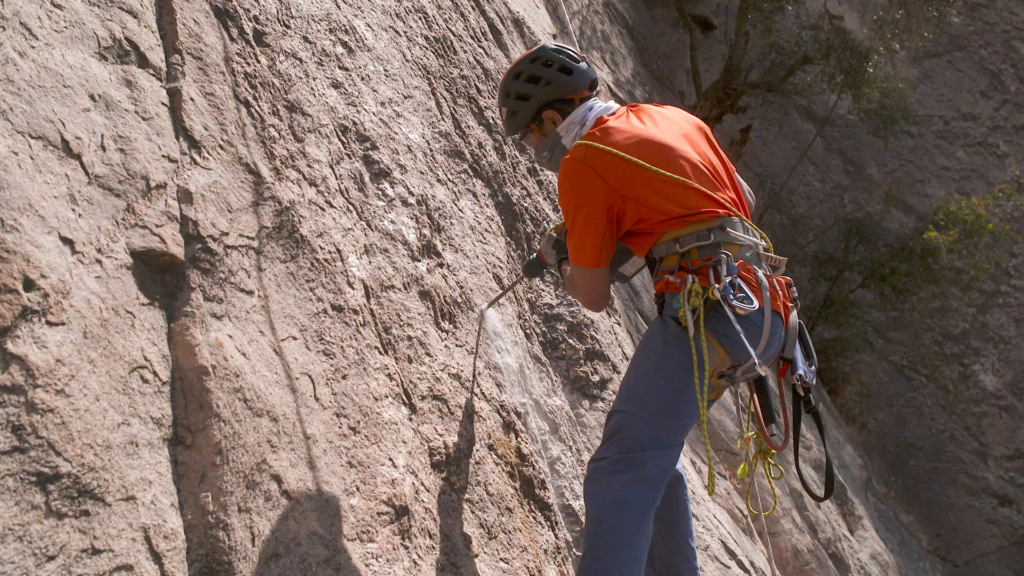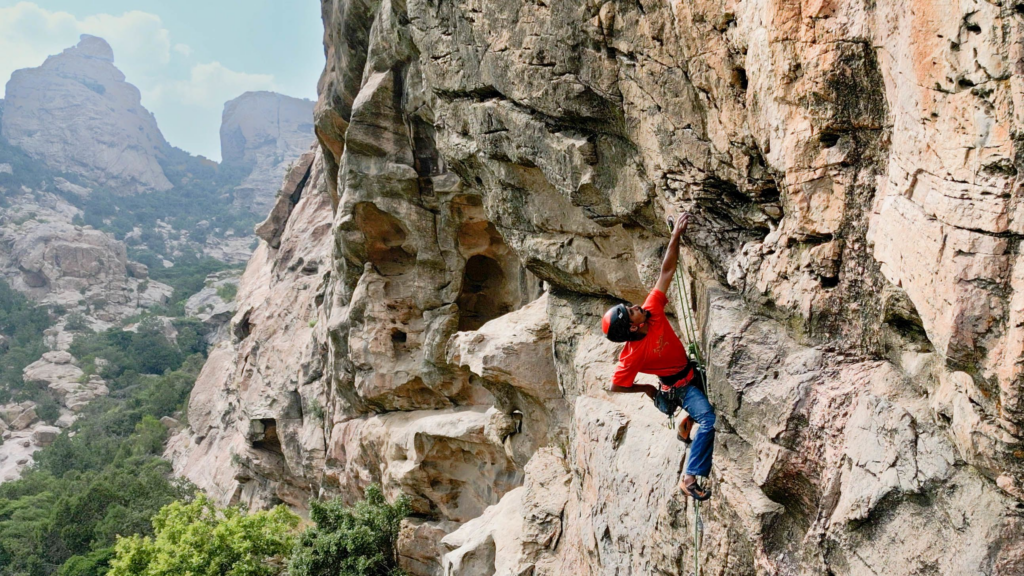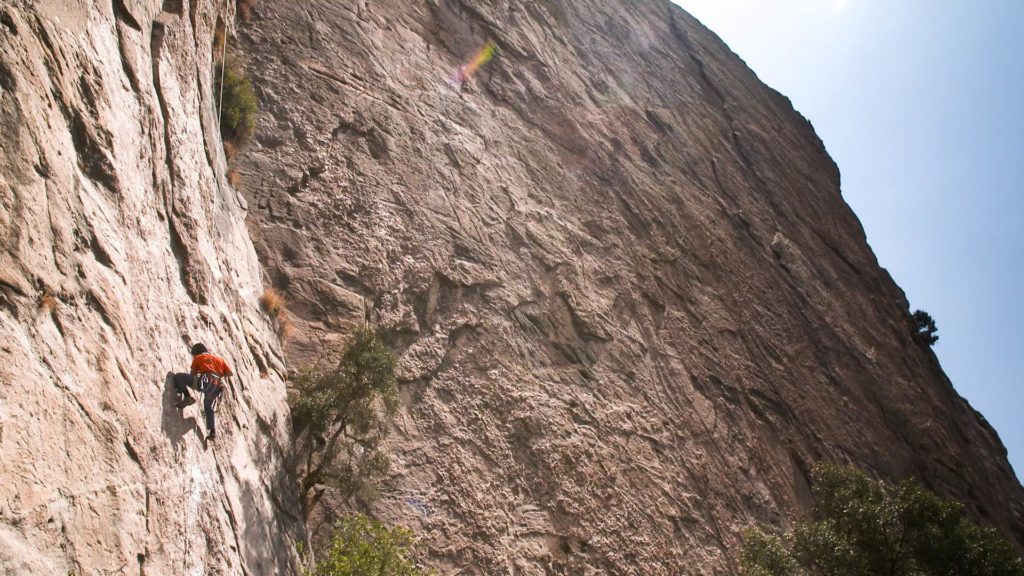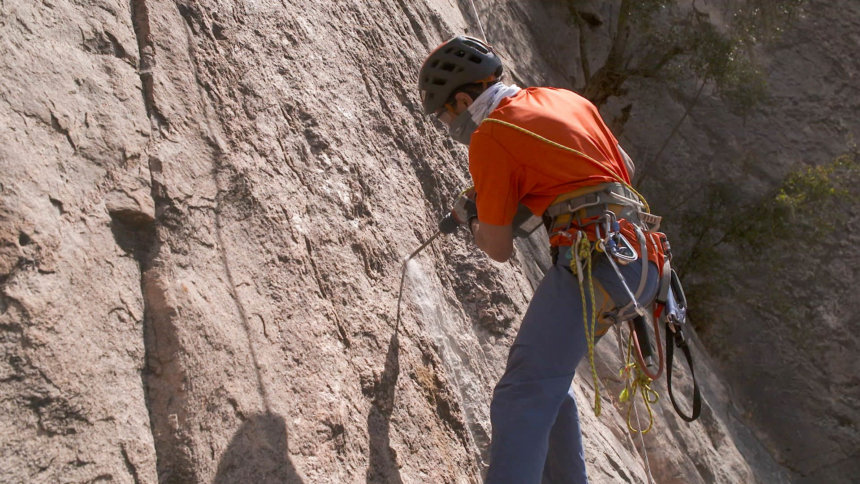Abdulrahman Alabdu hangs off the side of a cliff, drilling into the rock and placing stainless steel bolts in each hole. In this remote corner of Saudi Arabia, his tools are the only sound piercing the silence. He estimates that just 30 to 50 people from outside the region have ever stepped foot here.
“This area is really far from everyone,” he says, pausing from his work. “Maybe some hikers have come to explore. But… it’s mainly just the locals who live here and shepherd the sheep.”
Alabdu is Saudi Arabia’s first certified rock-climbing instructor. In his spare time, he establishes new climbing routes, hoping to attract more people to the sport. Over the past four years, he says he’s bolted 11 routes in Tanomah, a city in southwestern Saudi Arabia.
As Saudi invests in sports both abroad and at home, Alabdu says he wants to personally raise the profile of rock-climbing.
“Most people wouldn’t think [Saudi] is a climbing destination. And that’s what we’re working toward – to make it that, by having more routes, making them accessible and then promoting it.”
Spending big on sports

Saudi Arabia has been making global headlines in recent years for major sports investments. From lavish football contracts – including the 2034 soccer World Cup – to launching the LIV golf series, the country has spent billions on high-profile deals. Critics call this spending “sportwashing,” a way of diverting attention from its human rights record. But officials say it’s a strategy to diversify the oil-based economy as part of Saudi’s Vision 2030 plan.
At home, Saudi Arabia is also hard at work encouraging citizens to get more active and live healthier lives. The country hopes to boost the number of Saudis exercising once a week by 2030. To achieve this goal, the government organizes sports events, nationwide campaigns and competitions.
While football is Saudi’s most popular sport, between 2015 and 2022 the number of sports federations in the country tripled: Today, the country boasts over 95, including the Saudi Hiking and Climbing Federation, which was established in 2018.
Finding new routes in Saudi

Alabdu was born in the southwestern city of Abha and grew up between there and Jeddah. He began climbing in 2014 and, from Australia to Vietnam, he says he’s climbed in at least 17 countries. For a while, he thought he would only be able to pursue his passion abroad.
“When I first got back to Saudi … I couldn’t find that quality rock that I was climbing outside of Saudi,” he says. “I thought, ‘I’ll only climb when I travel.’ And that was a bit upsetting.”
Everything changed in 2016 when he visited Tanomah for the first time. The region has moderate temperatures most of the year and is home to the Sarawat Mountains, which stretch from southwestern Saudi to Yemen. Not only did Alabdu find more solid rock faces here, which are safer to climb, but the mountain range also offered a variety of climbable routes. And they were accessible from the town.
“[Tanomah] is a bit of a drive from Riyadh and also from Jeddah,” he explains. “But it’s worth it when you reach here because … you can easily get from the hotel to the crag in less than 10 minutes. And that I think is a big advantage.”
Inspired by this discovery, Alabdu travelled to Nevada to train with the American Mountain Guides Association (AMGA). In 2019, after completing the AMGA single-pitch instructor program, he became the first certified rock-climbing instructor in Saudi Arabia.
Sharing a passion

In 2021, Alabdu founded company that is now called Granite Climbing. He consults with the government and companies looking to establish either indoor or outdoor climbing activities in Saudi Arabia. He also leads expeditions for tourists looking to climb the country’s mountains. And he offers private and group lessons.
“A lot of people think that it’s hard as a sport, but in reality, it has all grades… from really easily accessible routes to really advanced routes,” Alabdu says as he rummages through tools in his backpack. “You’ll get people who think, ‘I will never be able to do this.’ And then they do it, and then they do another one, and then all of a sudden, they are rock climbers.”
“This is what I love about climbing and about teaching climbing.”
Alabdu estimates that he’s given about 300 people climbing lessons in Saudi. Most come for a single introductory course, but a handful have stayed on as regular clients.
When he’s not teaching, Alabdu is often in Tanomah bolting new routes. This involves first cleaning a rock face from any loose rock, deciding where to place the stainless steel bolts and then drilling them into place.
On this September morning, Alabdu is bolting a path on a crag in Alsharaf Park. He says that the rock face he’s working on is about 2,300 meters high. In addition to the 11 paths he’s charted in Tanomah, Alabdu says he’s bolted roughly 10 others in a small town south of Riyadh.
Alabdu’s bolting mission is inspired by his desire to share his passion with others. But he’s also quick to acknowledge his personal motivations as well. Many climbing trips require partners – someone to be on the ground, counterbalancing the climber, a technique known as belaying. And because climbing is still so new in Saudi, belayers can be hard to come by.
“That, generally, is a big issue in Saudi – to find climbing partners. But that’s usually resolved by making the climbing area popular,” Alabdu says. “The more traffic you have, the less problem you have finding partners.”
“Hopefully this will attract climbers from the GCC [Gulf countries], Saudi and then internationally as well. And this might sound selfish,” he says with a laugh. “But then I will always have belays.”
